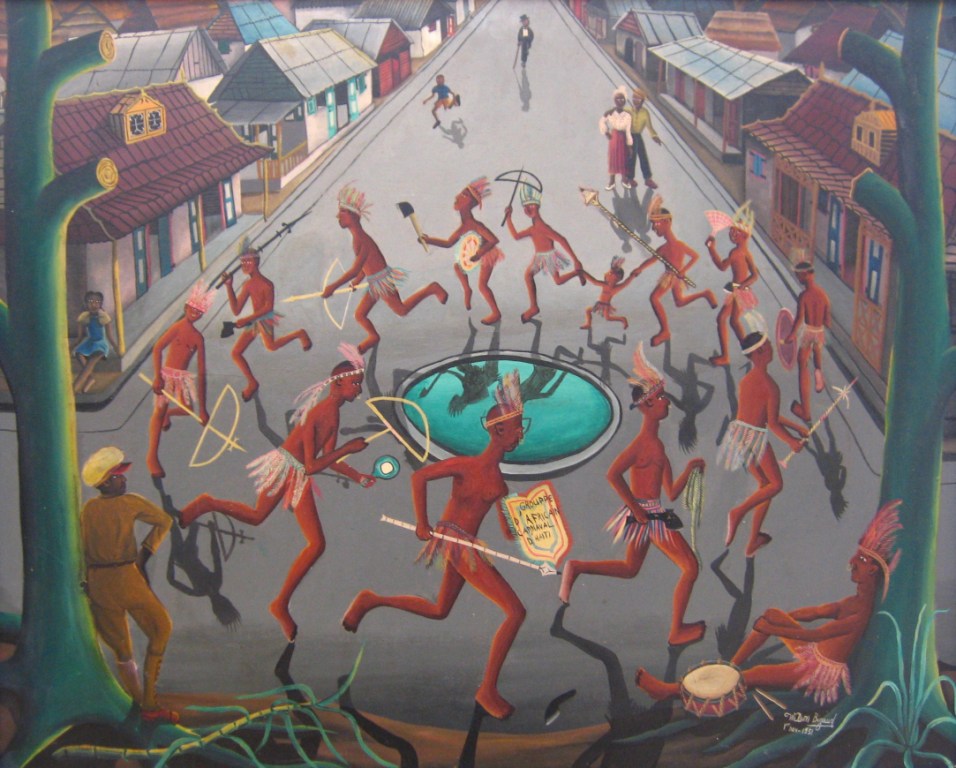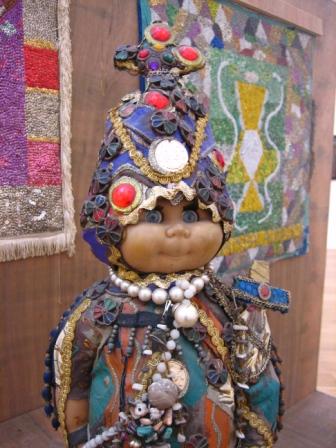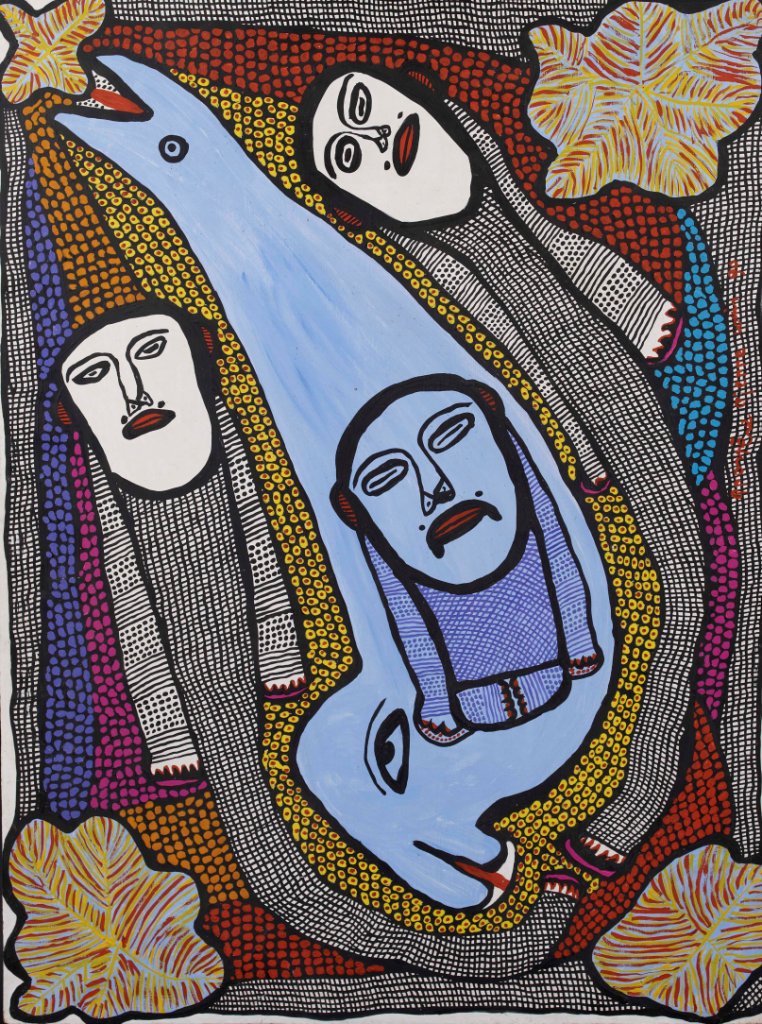Kafou: Haiti, Art and Vodou, Nottingham Contemporary | reviews, news & interviews
Kafou: Haiti, Art and Vodou, Nottingham Contemporary
Kafou: Haiti, Art and Vodou, Nottingham Contemporary
Edible enjoyment and surreal surprises in a magical feast of art
I’ve rarely come across an exhibition as loaded with context as this one. Voodoo – or Vodou, as the show has it – is a massively complex and contested phenomenon, from the pin-sticking and zombies of legend and fantasy to the no-less colourful reality. Haitian history is tragic and dramatic, fraught with misinformation stemming from the country’s creation in an 18th century slave revolt.
What we see when we actually get inside is more modest in scale and ambition than you might expect, but often beautiful. It is also highly revealing, not only about Haitian culture, but how we choose to present and think about art from outside the Western mainstream.
The initial impression is of a kind of magic realist folk art
Vodou, we are led to understand, is a blend of African and Christian beliefs incorporating elements of native Indian religion, Western occultism, freemasonry and whatever else takes its adherents’ fancy. Its iconography draws equally promiscuously from the imagery that comes its way, from baroque religious art to Princess Diana, Nastassja Kinski and Fred Flintstone, all of whom have appeared on Vodou altars in recent years. You won’t, however, meet this unlikely trinity in this exhibition. Apart from a few examples of sequinned and embroidered ‘secret flags’, none of the images and objects here are religious artefacts. While everything – or almost everything – here has been inspired by Vodou, it has all been created as ‘art’ of one sort or another.
Curated by Nottingham Contemporary’s director Alex Farquarson and photographer Leah Gordon (creator of the superb book Kanaval), the exhibition’s time frame begins in the 1940s, when Dewitt Peters, an American artist and teacher created the Centre d’Art, a gallery and informal art school in the Haitian capital Port au Prince. While the Centre d’Art was initially designed to promote Haitian Modernism, it became associated with so-called "naive art", the paintings of untutored peasants and artisans, such as Hector Hyppolite, a house painter and Vodou priest, and Benoit Rigaud, originally Peters’ driver. When the Surrealist leader Andre Breton visited the island in 1945 his enthusiasm for this work piqued the interest of international dealers and collectors, and a full-scale Haitian "primitive renaissance" was under way. This is the tradition, rejuvenated by subsequent movements, such as the 1970s Saint-Soloeil group, that this exhibition explores.

Hyppolite, technically perhaps the least adept, gives the greatest sense of getting Vodou ritual raw onto the canvas. Some of the other’s efforts – such as Wilson Bigaud’s wonderful Africaine Carnivale (pictured above) correspond so closely to what Andre Breton would have liked, you can’t help feeling they must have been influenced as well as promoted by him.
There’s the sense here of each of the artists struggling to evolve a personal visual language. But by the second room, of paintings by artists of the next generation, the work feels formulaic, with the artists applying an established manner to every work. Andre Pierre’s figures are covered in white patterns derived from ritual marks, that extend decoratively into the surrounding foliage. Camy Rocher uses lines of white dots that sit on the surface of the canvas to give his works structure.

It’s a relief to encounter three-dimensional pieces whether they’re Georges Liotaud’s silhouetted figures cut out of oil drums or Pierrot Barra’s extraordinary plastic dolls encrusted with psychedelic amalgams of fabric, sequins and cheap jewellery (pictured above left). It’s here that the exhibition starts to become genuinely weird and visionary, and that the work starts to overlap with so-called ‘outsider art’. Had we been told that Barra’s figures had been made by an inmate of a mental institution, we wouldn’t be the least bit surprised.
Some of the paintings of the Saint-Soleil group of farmer-artists, active in the 1970s, are overtly reminiscent of the legendary British outsider artist Scottie Wilson. This room contains some of the most compelling and out-there imagery in the exhibition (pictured below right, Prospere Pierre-Louis' Lwa in the Blue Bird, 1990) and simultaneously its prettiest and most child-like. The relationship with Outsider Art is the aspect of Haitian art most controversial among academics. But judging by this exhibition it’s difficult to say what the connection demonstrates other than the fundamental redundancy of the idea of Outsider Art.
 Bringing the exhibition up to date are larger paintings by Edouard Duval-Carrie and Frantz Zephirin, two Haitian contemporary artists who draw on voodoo imagery – Duval-Carrie the more effectively – and the sculptures of the Atis Rezistans group, who fuse urban detritus into quirky figures reminiscent of African power objects. More revealing than the objects themselves, however, is Leah Gordon’s film about the group – shown alongside – which throws both their work and the whole exhibition into fascinating relief. Far from appearing naive and provincial as you might expect, the artists are all fiercely articulate and highly conscious of their position as untrained contemporary artists working amid povery-stricken desperation. The wild assemblages of found objects filling their studios make the isolated objects in the surrounding exhibits seem relatively tame.
Bringing the exhibition up to date are larger paintings by Edouard Duval-Carrie and Frantz Zephirin, two Haitian contemporary artists who draw on voodoo imagery – Duval-Carrie the more effectively – and the sculptures of the Atis Rezistans group, who fuse urban detritus into quirky figures reminiscent of African power objects. More revealing than the objects themselves, however, is Leah Gordon’s film about the group – shown alongside – which throws both their work and the whole exhibition into fascinating relief. Far from appearing naive and provincial as you might expect, the artists are all fiercely articulate and highly conscious of their position as untrained contemporary artists working amid povery-stricken desperation. The wild assemblages of found objects filling their studios make the isolated objects in the surrounding exhibits seem relatively tame.
Glimpses of Vodou ceremonies bring home to you how much these rituals, like the African festivals that inspired them, are a kind of gesammtkunstwerk in their own right – a total work of art – in which many kinds of creativity are involved in ways that blur banal Western distinctions such as art, literature and music. Yet this sense of the essential liveness of Vodou is only fleetingly apparent in the show is a whole. What Dewitt Peters did at the Centre d’Art was to show Haitians how aspects of Vodou culture could be isolated and turned into art – which invariably means objects that can be easily transported and used, generally for decorative purposes, by collectors and tourists. This exhibition is a kind of history of that process. And that isn’t to be derided: the history it records is what has happened. If we aren’t shown the contents of ghetto artists’ studios in room-filling installations, that is probably because the artists themselves don’t conceive of their work in those terms. If we’re not seeing Vodou-inspired Haitian performance art, maybe there isn’t any.
This is a fascinating exhibition, well worth travelling to see, but the totality of Vodou and what it has to offer to art remain largely out of view, a massive partially charted area full of possibilities.
- Kafou: Haiti, Art and Vodou runs at Nottingham Contemporary until 6 January
Explore topics
Share this article
The future of Arts Journalism
You can stop theartsdesk.com closing!
We urgently need financing to survive. Our fundraising drive has thus far raised £49,000 but we need to reach £100,000 or we will be forced to close. Please contribute here: https://gofund.me/c3f6033d
And if you can forward this information to anyone who might assist, we’d be grateful.

Subscribe to theartsdesk.com
Thank you for continuing to read our work on theartsdesk.com. For unlimited access to every article in its entirety, including our archive of more than 15,000 pieces, we're asking for £5 per month or £40 per year. We feel it's a very good deal, and hope you do too.
To take a subscription now simply click here.
And if you're looking for that extra gift for a friend or family member, why not treat them to a theartsdesk.com gift subscription?
more Visual arts
 'We are bowled over!' Thank you for your messages of love and support
Much-appreciated words of commendation from readers and the cultural community
'We are bowled over!' Thank you for your messages of love and support
Much-appreciated words of commendation from readers and the cultural community
 Lee Miller, Tate Britain review - an extraordinary career that remains an enigma
Fashion photographer, artist or war reporter; will the real Lee Miller please step forward?
Lee Miller, Tate Britain review - an extraordinary career that remains an enigma
Fashion photographer, artist or war reporter; will the real Lee Miller please step forward?
 Kerry James Marshall: The Histories, Royal Academy review - a triumphant celebration of blackness
Room after room of glorious paintings
Kerry James Marshall: The Histories, Royal Academy review - a triumphant celebration of blackness
Room after room of glorious paintings
 Folkestone Triennial 2025 - landscape, seascape, art lovers' escape
Locally rooted festival brings home many but not all global concerns
Folkestone Triennial 2025 - landscape, seascape, art lovers' escape
Locally rooted festival brings home many but not all global concerns
 Sir Brian Clarke (1953-2025) - a personal tribute
Remembering an artist with a gift for the transcendent
Sir Brian Clarke (1953-2025) - a personal tribute
Remembering an artist with a gift for the transcendent
 Emily Kam Kngwarray, Tate Modern review - glimpses of another world
Pictures that are an affirmation of belonging
Emily Kam Kngwarray, Tate Modern review - glimpses of another world
Pictures that are an affirmation of belonging
 Kiefer / Van Gogh, Royal Academy review - a pairing of opposites
Small scale intensity meets large scale melodrama
Kiefer / Van Gogh, Royal Academy review - a pairing of opposites
Small scale intensity meets large scale melodrama
 Jenny Saville: The Anatomy of Painting, National Portrait Gallery review - a protégé losing her way
A brilliant painter in search of a worthwhile subject
Jenny Saville: The Anatomy of Painting, National Portrait Gallery review - a protégé losing her way
A brilliant painter in search of a worthwhile subject
 Abstract Erotic, Courtauld Gallery review - sculpture that is sensuous, funny and subversive
Testing the boundaries of good taste, and winning
Abstract Erotic, Courtauld Gallery review - sculpture that is sensuous, funny and subversive
Testing the boundaries of good taste, and winning
 Edward Burra, Tate Britain review - watercolour made mainstream
Social satire with a nasty bite
Edward Burra, Tate Britain review - watercolour made mainstream
Social satire with a nasty bite
 Ithell Colquhoun, Tate Britain review - revelations of a weird and wonderful world
Emanations from the unconscious
Ithell Colquhoun, Tate Britain review - revelations of a weird and wonderful world
Emanations from the unconscious
 Rachel Jones: Gated Canyons, Dulwich Picture Gallery review - teeth with a real bite
Mouths have never looked so good
Rachel Jones: Gated Canyons, Dulwich Picture Gallery review - teeth with a real bite
Mouths have never looked so good

Add comment